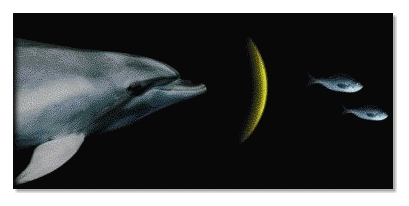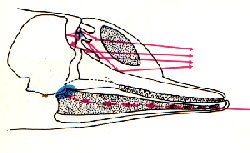
In
the last three decades, improved technology has allowed man to investigate
the complex system of underwater hearing by cetaceans. Using the
basic mammalian apparatus, developed on land, cetaceans have adapted it
for use in water so efficiently that hearing has become their primary sense. Unlike
sharks and rays which have a well developed sense of smell, the cetaceans
have virtually dispensed with olfaction as a method of gaining information
about their environment. Sight
is moderately developed in some species, while the sense of touch is restricted
to close contact. The
cetacean emits sound waves which create echoes used to furnish information
about the general topography of an aria, and to locate food.
Unlike
sharks and rays which have a well developed sense of smell, the cetaceans
have virtually dispensed with olfaction as a method of gaining information
about their environment. Sight
is moderately developed in some species, while the sense of touch is restricted
to close contact. The
cetacean emits sound waves which create echoes used to furnish information
about the general topography of an aria, and to locate food.
Sounds
are also used to give warning of enemies and to keep in contact with members
of their own species. This
system resembles the asdic or sonar used by navies to locate submarines
or to gain information about the sea bottom. Basically three broad groups
of sound are used. For
information about the topography, low frequency clicks, which have great
penetrating power, are used. For communication between members of the same
species, somewhat higher frequency whistles are used, while location of
food may depend on higher frequency clicks. Coupled
with these variations in frequency must go direction-finding.
Both
ears receive information independently, thus giving a directional fix which
is then interpreted by the brain.
 In
order that the cetacean ear could be used for the reception of underwater
sounds, modification of the land mammalian pattern, unsuitable for hearing
underwater, was necessary. The
middle ear has become much enlarged and is more rigid since the pressures
involved are greater while the movements of the enclosed structures are
much less. The
inner ear has also been modified to receive much higher frequencies since
the same resolving ability requires frequencies four times higher in water
than air. When
the normal air-adapted mammalian ears are placed in the water, they lose
their direction-finding ability , since the vibration caused in the skull,
by soundwaves, does not allow the animal to separate the reception of its
two ears. In cetaceans, the ears are surrounded by air-filled cavities,
which re-establish separate function and allow directional interpretation
by the brain.
In
order that the cetacean ear could be used for the reception of underwater
sounds, modification of the land mammalian pattern, unsuitable for hearing
underwater, was necessary. The
middle ear has become much enlarged and is more rigid since the pressures
involved are greater while the movements of the enclosed structures are
much less. The
inner ear has also been modified to receive much higher frequencies since
the same resolving ability requires frequencies four times higher in water
than air. When
the normal air-adapted mammalian ears are placed in the water, they lose
their direction-finding ability , since the vibration caused in the skull,
by soundwaves, does not allow the animal to separate the reception of its
two ears. In cetaceans, the ears are surrounded by air-filled cavities,
which re-establish separate function and allow directional interpretation
by the brain.
Experiments
have shown that as well as gaining a great deal of information about the
size and position of underwater objects, including the topography, cetaceans
can probably decipher their form and even their structure.
Such
an ability is essential if food is to be identified.
The
experiments show that the bottlenosed dolphin is able to distinguish between
a piece of dead fish and an object of exactly the same shape, using sound
alone. It
is assumed that cetaceans can defect differences in the reflection and
absorption of soundwaves by different materials. the variety of sounds
used by some cetaceans is legion. 
The
bottlenosed dolphin has been the subject of much study and in this species
clicks, quacks and whistles have been described.
In
addition, these animals may use both left and right nasal sacs independently,
thus the right hole may whistle as the left clicks.
It
is now clear, that the use of sound is of primary importance to the Cetacea,
and they have developed a wide series of different sounds and sonic techniques,
which allow them to exploit fully the physical apparatus.
In
addition the brain has evolved a very complex structure in relation to
the reception and interpretation of sound. Structurally the cerebral cortex
is similar to that of man.
The
sound transmitted between animals of the same species are extremely complex,
it seems probable that communication has reached a high degree of sophistication
in the Cetacea. It
should be stressed that most of our knowledge of sound communication comes
from the Odontoceti and that it is not possible to attribute similar sophistication
to members of the Mysteceti.

 Unlike
sharks and rays which have a well developed sense of smell, the cetaceans
have virtually dispensed with olfaction as a method of gaining information
about their environment. Sight
is moderately developed in some species, while the sense of touch is restricted
to close contact. The
cetacean emits sound waves which create echoes used to furnish information
about the general topography of an aria, and to locate food.
Unlike
sharks and rays which have a well developed sense of smell, the cetaceans
have virtually dispensed with olfaction as a method of gaining information
about their environment. Sight
is moderately developed in some species, while the sense of touch is restricted
to close contact. The
cetacean emits sound waves which create echoes used to furnish information
about the general topography of an aria, and to locate food.

